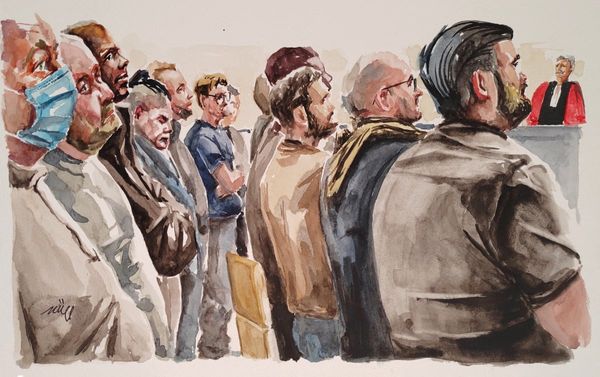Darrick Hamilton grew up shuttling between two worlds. Each morning during the 1970s and ’80s he and his sister would travel three miles to Brooklyn Friends, the elite private Quaker school that their parents had scrimped, saved, and sacrificed to afford. Then the kids would return from downtown Brooklyn to Bedford-Stuyvesant, which was overwhelmingly Black, largely poor, and one of New York’s most dangerous neighborhoods.
At the time, pundits and politicians frequently talked of a “culture of poverty” or a “pathology” in Black “ghettos.” That didn’t compute for Hamilton. “I could see the vivid inequality,” he says, but “I could see fundamentally people were not different.” The neighbor he played football with who was later incarcerated for robbing an armored car didn’t seem essentially different from the classmate who might be an investment banker today.
By the standards of Bed-Stuy, Hamilton was privileged. His family owned their home, and in Brooklyn Friends he had a place where he could thrive. A precocious and popular student, he took to heart the Quaker emphasis on social justice and morality. Most of all, he had parents who were devoted to getting their children ahead, no matter the cost.
Now 51, Hamilton is a professor at the New School in New York, a leading scholar in the emerging field of stratification economics, and a policy adviser to senators, governors, and presidential candidates. One of his cornerstone ideas, to give “baby bonds” to each child, is being embraced and implemented by governments across the U.S. He insists, though, that this success shouldn’t be celebrated as a triumph over adversity. He despises the way classic rags-to-riches stories can be used to cast blame on those who can’t climb out of poverty. Such narratives ignore the economic stratification that can make success possible only with extraordinary luck or inhuman levels of personal sacrifice.
Hamilton’s triumph came at a traumatic cost. In 1988, a few months before he turned 18, his mother passed away after a long struggle with health issues. A month after Hamilton’s birthday, his father died, too. He blames their untimely deaths on their incessant striving. “I saw their struggles and I saw their brilliance,” he says. But despite their creativity and entrepreneurship, they could never achieve the same security as his classmates’ parents.
Basketball became Hamilton’s solace. Despite standing just 5 feet, 8 inches, he became a star at Brooklyn Friends. The school rallied around him, and he finished his senior year tuition-free. He followed some close friends to Oberlin College, where he chose economics as his major. “I didn’t want to be poor,” he explains. He thought the subject might be a bridge to law or business school, but, in keeping with his alma mater’s Quaker ideals, he decided he could do some good in economics, with a focus on the racial disparities he’d grown up observing.
After getting a Ph.D. from the University of North Carolina, Hamilton became a leading researcher of the U.S. racial wealth gap and a font of policy proposals to address it, advocating ideas such as reparations and a federal job guarantee as part of a broader set of economic rights. In 2018 he appeared onstage at an “Inequality Town Hall” with Senators Bernie Sanders and Elizabeth Warren and filmmaker Michael Moore. Two years later, at Sanders’s behest, Hamilton served on the Biden-Sanders Unity Task Force, an effort to iron out policy differences among Democrats and help shape the party’s platform.
It was his advocacy of baby bonds, though, that brought his academic work off progressive wish lists and into the real world. Hamilton developed the idea a dozen years ago, proposing to give each baby born in the U.S. a trust fund established and guaranteed by the federal government. The goal is to narrow the vast inequalities that exist at the moment of birth, particularly those related to the wide and persistent racial wealth gap. The bonds could give any disadvantaged 18-year-old resources to catch up to wealthier peers. “The fundamental point is providing people with capital at a key point in their life, so they can get into an asset that will passively appreciate over their lifetime,” Hamilton says. And, because race correlates so closely with wealth in the U.S., the policy can be officially race-neutral while still giving a substantial boost to Black Americans who for centuries have been denied opportunities to build intergenerational wealth.
Propelled by the Black Lives Matter protests that took place after the murder of George Floyd, lawmakers in Connecticut and the District of Columbia recently established programs that will set aside money for thousands of babies. Washington state is taking steps toward a similar program that could launch in 2024. New Jersey’s governor has also pushed a plan to issue them. And Massachusetts’ treasurer is launching a “baby bonds task force” this spring. “There’s so much happening fairly quickly and suddenly at the state level,” says Shira Markoff, policy fellow at Prosperity Now, a nonprofit pushing the idea around the country.
The state initiatives depart from what Hamilton envisioned in key ways, but he argues that they’re a “big giant first step” that will help recipients, demonstrate baby bonds’ political appeal, and allow states to experiment with different ways of implementing them. “What these programs do is create the political infrastructure by which the federal government will act,” he says.
Early in Hamilton’s career, whenever someone in academic or policy circles asked him about the racial wealth gap, he would bring up the possibility of the federal government paying reparations to Black Americans for slavery and other historical wrongs. The median White family in the U.S. has eight times more wealth than the typical Black family, according to the latest Federal Reserve data, from 2019. And a 2020 study by Naomi Zewde of the City University of New York found that the median White adult has 16 times the wealth of her Black counterpart. A substantial reparations program could do a lot to close the gap, but Hamilton’s listeners rarely wanted to hear it. “People [were] basically telling me to shut up,” he says. “There he goes again.”
Then he was asked at a forum convened by the Ford Foundation to come up with a more politically feasible way of building up Black wealth. “Give us something that can actually happen,” he recalls being told. The answer would be baby bonds, laid out in a 2010 academic paper by Hamilton and his graduate adviser and then-frequent co-author William Darity Jr., who’s now an economics professor at Duke University.
The basic notion of giving cash to people when they reach the age of maturity is hundreds of years old. Decades after advocating for the American Revolution, Thomas Paine published a pamphlet in England in 1797 arguing that, as compensation for unfair land distribution, every person should be granted £15 (about £2,000, or $2,600 today) at age 21. “It is a right, and not a charity, that I am pleading for,” Paine wrote. The term “baby bond” eventually came to be used to refer to savings accounts for children that were seeded with small amounts of money to encourage their parents to save. Britain took a big step toward creating a government-run baby bond program, the U.K. Child Trust Fund, for each baby born after September 2002, but it stopped contributing new money in 2011 after budget cuts. And when Hillary Clinton ran for president in 2007, she briefly floated the idea of giving each American newborn a $5,000 bond.
Like these ideas, Hamilton-style baby bonds aren’t technically bonds, which in finance are debt securities sold by companies or governments and traded among investors. They’re really trust funds, ones Hamilton thinks should be guaranteed by the federal government, like Social Security. At age 18, kids could tap into the accounts for certain wealth-building purposes, including education, homeownership, small-business startup costs, and retirement savings. While all or most babies would get a bond, the poorest kids would get the largest stakes—as much as $60,000 each.
Hamilton, Darity, and other scholars spent decades laying the intellectual foundations for the idea, publishing research that stressed the importance of focusing on wealth and not just income or education. “Wealth provides financial agency over one’s life,” Hamilton told the National Economic Association in a 2017 speech. “Wealth gives you choice. It provides the economic security to take risks and shield against financial loss.” With wealth, you can afford the best health care, live in the safest neighborhoods, get the best education, and hire the best lawyers to fight for your interests. Wealth lets you innovate and try new things, like opening a business. Most of all, once you have wealth, it can be invested and grow exponentially over your lifetime. And you can pass this wealth and all its advantages down to the next generation.
The racial wealth gap hasn’t significantly narrowed since 1983, the year it started being consistently tracked, despite hopes that it would shrink as discriminatory laws were repealed and Black Americans made gains in income, education, and other areas. Too often, Hamilton says, Black people have been blamed for this lack of progress. But the gap can’t be closed solely with hard work, better education, and saving more. Fed data for 2019 show that the median Black household with at least one college graduate had less than half the wealth of the median White household where the highest level of education is a high school diploma. And several studies suggest that Black people save more as a percentage of their incomes than White people do.
The larger problem, in Hamilton’s view, is that Black families are starting from too far behind, because they inherit so much less from their parents. The goal of baby bonds is to tackle the wealth gap they and other poor families face head-on, by giving young people capital when they’re on the cusp of adulthood. “Baby bonds would be almost an automatic stabilizer,” Hamilton says. It’s “a mechanism to redress some of the inheritable advantages or disadvantages that go along with families and life.”
Hamilton finds it difficult to talk about his teenage years. His parents’ deaths aren’t a talking point in his frequent testimony or public appearances. Usually loquacious, he tells the story of his childhood haltingly, through tears.
His father, Charles, was a community leader, an entrepreneur who “could literally make a dollar out of fifteen cents.” To earn the money that put Hamilton and his sister into private school, Charles worked as a property manager for Brooklyn landlords, often in high-crime areas. At a tenants’ meeting one day, he was attacked. He took out a gun he carried for protection and shot and killed his assailant. Hamilton’s mother, Norma Jean, used some money she’d come into from a medical malpractice settlement to hire a good lawyer for her husband, but he was still convicted of manslaughter and spent several years in prison.
Hamilton says his father’s hard work and creativity “never put him in a place where he could remove himself from the vulnerabilities that, in my mind, led to his incarceration.” With Charles in prison, the burdens of raising two children fell on Norma Jean: “She was going to make sure that we were going to get through school.” They did, but not before she was diagnosed with a serious liver condition that Hamilton believes was stress-induced.
After being released from prison, Charles had trouble rebuilding his life. Drugs “became part of coping with things,” Hamilton says. Charles eventually contracted HIV, but he was at his wife’s bedside when she died in May 1988 following an unsuccessful liver transplant. He died of AIDS the next October. “It was quick,” Hamilton says. “I didn’t know about it until he got really sick.”
His parents had been relatively fortunate to own their house, bought in the 1970s after his father’s father drew on a veterans loan program that effectively excluded many other Black vets. But after their deaths, the family lost the home in a foreclosure. Hamilton says that if he’d received a baby bond around that time, he might have been able to save the home, which went on to multiply in value as Bed-Stuy gentrified in subsequent decades. It’s easier still to imagine how the bonds might have helped his parents. His mother might have avoided the financial insecurity and stress that led up to her death. His father might have built a portfolio of properties rather than managing them for others.
The forces that pulled and pushed at Hamilton’s parents are still keeping Black families poorer than other Americans. The broader problem, according to Hamilton and other scholars in the field of stratification economics, is that racial discrimination has staying power. Traditional economists often assume that something as irrational as racism will fade away in a capitalist economy, as market forces narrow the disparities among groups. Stratification scholars say economics needs to be more aware of the power dynamics that undergird racism, arguing that discrimination is driven by dominant groups trying to preserve or enhance their position in the social hierarchy.
Through this lens, understanding the economy means taking into account the U.S.’s extraordinarily brutal history and how it distributed wealth to some families and not others. As Hamilton frequently points out, the legacy of slavery is just one example of how the White wealth of today was created by the policies of the past. A forthcoming paper he co-authored considers agricultural policies following the post-Civil War period, when Black farmers managed to acquire millions of acres of land. Over the course of the 20th century, the research found, the U.S. Department of Agriculture worked with banks and White elites to discriminate against Black farmers seeking loans and other aid, ultimately causing them to lose almost 90% of their land. Hamilton and his co-authors put the compound value of this lost land at roughly $326 billion.
He often reminds audiences that the U.S. government also gave White families an overwhelming advantage in how it distributed free land to settlers in the 19th century, how it set up the New Deal safety net in the 1930s, and how it doled out GI Bill mortgages and education benefits to veterans. In addition to denying millions of Black Americans these wealth-building entitlements, the government at times allowed and even encouraged the theft and destruction of Black property, sometimes in acts of terror—the 1921 Tulsa Race Massacre is just one example of many.
To address the resulting disparities, Hamilton has advocated many policies that fall under the category of “inclusive economic rights,” among them a guaranteed income and single-payer health insurance. He’s also backed ideas, such as debt-free college and student loan forgiveness, that would benefit many White Americans. “Coming up with the policies is not as esoteric and difficult as it may seem,” he says. “Maybe I’m naive, but if you see a problem you directly redress it.”
Stephanie Kelton, another economist and Sanders supporter who served on the Biden-Sanders task force, says Hamilton’s advantage in policy circles is that “he’s a very fierce advocate and at the same time a very affable person.” He’s also “not afraid to put big ideas on the table.”
Hamilton has lately been chatting with major philanthropic foundations about baby bonds, suggesting that they try giving out grants to a group of high school seniors to test the concept. “Why wait 25 years to see if these accounts are going to work?” he asks. And for that matter, “Why should baby bonds be limited to the United States?”
Baby bonds came to wider public attention in the U.S. in 2019, when New Jersey Senator Cory Booker ran for president on a platform that featured a federal baby bonds program. Hamilton had helped craft the proposal; his tireless advocacy for the idea prompted Booker to dub him, aptly, “the intellectual father of baby bonds.” But the momentum for the idea really gathered after the murder of George Floyd by police in May 2020, sparking a reckoning that saw lawmakers scrambling for policies that might address the striking disparities between Black and White Americans.
The first state to adopt a Hamilton-style baby bonds program was, by some measures, the country’s richest and least equal. Connecticut can boast one of the highest average incomes in the U.S., thanks to the hedge fund billionaires and other finance professionals who live in Greenwich and other suburbs of New York City. But its cities contain pockets of deep, persistent poverty. “Connecticut is ground zero for wealth disparity as well as income disparity,” says Shawn Wooden, who grew up in the impoverished North End of Hartford, the capital, and was elected state treasurer in 2018.
Wooden brought his baby bonds proposal to Connecticut’s legislature in early 2021, and by July it was law. The District of Columbia moved about as quickly, beginning debate in May and passing its law in December. Wooden says the combination of widespread pressure to tackle racial disparities and Hamilton’s “intellectual framework” prompted advocacy groups and legislators in Connecticut to line up swiftly behind an idea that was new to most of them. To broaden the coalition, proponents argued that baby bonds wouldn’t just heal racial divisions but regional ones, helping poor, largely Black and Democratic urban neighborhoods and poor, largely White and Republican rural areas alike. Wooden tried to demonstrate to lawmakers that there were families in every one of the state’s 169 towns, including Greenwich, that could qualify for baby bonds. “Part of the messaging around this is it’s not race-based,” he says. “This is a program that is antipoverty regardless of your race or ZIP code.”
Governments are keeping costs down by covering only the poorest children, those eligible for Medicaid. In Connecticut, that’s more than 16,000 babies a year, about half of all births in the state. They’ll start with $3,200, which could grow to more than $10,000 by the time they’re 18, depending on investment performance—the state will put the initial capital pool into a broad range of asset classes, much like a pension plan. To ensure stable funding, Connecticut will issue about $50 million in bonds annually. The District of Columbia will spend $32 million over four years on its program, with qualifying babies starting with $500 and receiving as much as $1,000 extra for each year their parents’ income is below three times the poverty level.
To those wary of government spending programs, advocates argue baby bonds are inherently conservative—money set aside to meet future needs. “We’re not creating debt, we are just investing,” says Washington State Treasurer Mike Pellicciotti, who’s championing a baby bonds program that would be called the Washington Future Fund. “This is a way to bring capital to those communities, wherever they are, that are denied capital or have had capital drain.” The bill the state is debating would have it spend approximately $128 million a year for a program covering about half the babies born annually in Washington. As in Connecticut, each would have $3,200 to start, with growth dependent on investment performance.
And as in Connecticut, the sponsors of Washington’s bill have been surprised by the initial enthusiasm. The state’s legislature recently allocated money for a committee to develop a detailed baby bonds proposal by December. “A really bold idea in such a short time got more attention than I expected,” says Monica Stonier, a Democratic representative from the western part of the state. “The goal is broadly supported, it’s just a matter of how we get there.” The bill also attracted a couple of GOP co-sponsors. Another Republican state representative, Mike Volz, from Spokane, sponsored a constitutional amendment that would allow baby bond funds to be invested in a wider array of assets, though he says he doesn’t know what he’ll do when the main bill comes up for a vote next year. “I did commend the treasurer on his creativity,” he says. “It’s not the worst idea ever.”
The “baby” part of “baby bonds” may be what gives them uniquely broad political appeal, Hamilton says. The idea of granting a birthright to each child avoids the typical and often racially loaded debates about who’s deserving and undeserving of help. It’s hard to attack a baby for being lazy, he points out.
Along with not being federal, the state programs depart from Hamilton’s vision by being far less generous. Only the U.S. government has the resources to give poor kids the amount of money they’d need to launch themselves into the middle class, he says. According to Zewde’s 2020 study, a Hamilton-style $80 billion-per-year universal federal baby bonds program—amounting to almost 2% of the pre-pandemic federal budget—could narrow the racial wealth gap between the median White and Black young adult from a factor of 16 to a factor of 1.4.
Although the state programs are much smaller than Hamilton’s original proposal, Wooden points to the intangible benefits the bonds will bring. When children know they’ll be receiving baby bonds, he says, they may study a little harder, save their own money, and make plans for the future. “When you have hope, it changes everything,” he says.
Some progressives worry about overselling the benefits. Darity, Hamilton’s co-author on the paper that first floated the baby bonds concept, has expressed concern that even a full-scale federal program wouldn’t have a significant impact on the overall racial wealth gap. Baby bonds may narrow disparities when you compare the median Black and White recipients, Darity says, but focusing on the median misses the huge amounts of wealth held by the richest White families. “It’s a great idea to provide each newborn child, as a right, an asset that they can access when they come of age,” he maintains. But reparations are still needed to address the damage to the wealth of Black families across generations. “From the standpoint of justice and a debt that is owed, the entire racial wealth gap needs to be erased,” he says. He pegs the total cost at about $14 trillion.
Hamilton says both baby bonds and reparations are necessary, referring to them as “complements, not substitutes.” But he and Darity have split on, among other things, how to calculate the cost of reparations. Hamilton says using the entire racial wealth gap as the benchmark is too simplistic. The government needs to do a detailed historical accounting of “the present value of what was lost.”
His ultimate goal of a federal baby bonds program remains far away. Just 15 other senators have publicly backed Booker’s baby bonds bill, also introduced in the House by Massachusetts Democratic Representative Ayanna Pressley. It was never considered as part of Biden’s now-stalled economic agenda. But Hamilton remains optimistic, almost as a matter of principle. “The thing that will definitely get in the way of this occurring is pessimism,” he told a group of advocates at a virtual conference on baby bonds last month. “We shouldn’t wait on the federal government.” By starting at the state and local level, he said, “we make them do it, we build up momentum.”
Hamilton isn’t religious, but he can still sound like the Quakers who educated him. “I’m for economic justice, or justice more broadly. I pursue justice as a matter of faith,” he says. “I’ll go back to my theology: Do it because it’s the right thing to do.” He doesn’t want it to be as difficult for others as it was for his parents to set their child up for success. “If I had that choice, I would not have given up their life in order to have the access I had,” he says. “That drives me, because I saw the pain firsthand and I don’t want people to experience it. I think it’s profoundly unjust.”
©2022 Bloomberg L.P.







